|
|
|
 |
|
| Hanwei Shinto Blade in Shirasaya (SH1094) |
Points: 30

|
For those wishing to build a custom Samurai sword on a Hanwei blade, we offer in Shirasaya the blade used in the Shinto Katana, which has met the cutting demands of users worldwide. It is forged and differentially tempered in the traditional fashion, with a distinctive hamon, and is pre-fitted with its habaki. The hardwood Shirasaya is solidly made to provide safe storage of the blade.
Hand forged high-carbon steel blade
Differentially tempered
Pre-fitted Habaki
Sold Out
|
|
|
|
|
|
 |
|
| Hanwei Shinto Katana (SH1001) |
Points: 30

|
Each piece in the Shinto Daisho (SH1001 & SH1015) has a hand-forged T10 high-carbon steel blade (nagasa) and is differentially tempered using a traditional claying method. The Shinto Daisho is mounted in black and the tsuka-ito is made of premium black Japanese cotton. The saya is done in a deep black lacquer with a black cotton sageo. A finely rendered dragon, detailed in gold, with true front-and-back detail, forms the black iron tsuba. The fittings are superbly antiqued adding to the aesthetics of the set. The blades feature a groove (bo-hi) on both sides and are constructed with a medium length (chu) kissaki. The incredibly popular Shinto Daisho is the cornerstone of our CAS/Hanwei line of Samurai weapons.
Forged high-carbon steel blade
Built for cutting
Traditional construction
Sold Out
|
|
|
|
|
|
 |
|
| Hanwei Shinto Wakizashi (SH1015) |
Points: 25

|
Each piece in the Shinto Daisho (SH1001 & SH1015) has a hand-forged 1065 high-carbon steel blade (nagasa) and is differentially tempered using a traditional claying method. The Shinto Daisho is mounted in black and the tsuka-ito is made of premium black Japanese cotton. The saya is done in a deep black lacquer with a black cotton sageo. A finely rendered dragon, detailed in gold, with true front-and-back detail, forms the black iron tsuba. The fittings are superbly antiqued adding to the aesthetics of the set. The blades feature a groove (bo-hi) on both sides and are constructed with a medium length (chu) kissaki. The incredibly popular Shinto Daisho is the cornerstone of our CAS/Hanwei line of Samurai weapons.
Hand forged Steel
Edge-tempered blade with hamon.
Traditional construction
Sold Out
|
|
|
|
|
|
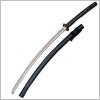 |
|
| Hanwei Miyamoto Musashi Daito (SH1016) |
Points: 30
|
Miyamoto Musashi, arguably the most famous swordmaster in Japanese history, fought more than 60 duels before retiring and writing his famous treatise on swordplay, the "Book of Five Rings". Musashi was well above average height and his Daito (long sword) was made to match his size. Development of the two-sword style of swordplay, with the Daito (long sword) and Wakizashi being used together, is credited to Musashi. Fittingly, we are able to offer both pieces with matching mounts. The Hanwei reproduction of the Musashi Daisho (SH1016, SH1017) is faithful to the original down to the famous double-ring iron tsubas. The Musashi Katana is mounted in black, with subtle copper inlays in the saya, and the tsuka-ito is in leather over ray skin. The blade is hand-forged in high-carbon steel and is edge-tempered using the traditional clay tempering method, resulting in a distinct hamon. Edge hardness is 60HRC, back hardness 40HRC. The grip is double-pegged to the tang for safety. Supplied with a protective cloth bag and traditional maintenance kit.
Forged high-carbon steel blade
Built for cutting
Traditional construction
Sold Out
|
|
|
|
|
|
 |
|
| Hanwei Miyamoto Musashi Wakizashi (SH1017) |
Points: 20
|
During the Muromachi period (1568-1603), the introduction of the pairing of the Katana (the curved sword) and Wakizashi was introduced. The Wakizashi, or the shorter companion blade to the Katana, was about 18 inches long. Only the warrior class - the Samurai - was allowed to wear the two swords, which remained a custom for the next several hundred years until abolished in the 19th century. This Wakizashi is the companion piece to the Musashi Miyamoto Katana (SH1016) with matching fittings and blade construction. Supplied with a protective cloth bag and traditional maintenance kit.
Hand forged high-carbon steel
Built for cutting
Traditional construction
Sold Out
|
|
|
|
|
|
 |
|
| Hanwei Great Wave - Tsunami Wakizashi (SH5002) |
Points: 30

|
Each piece in the Great wave Series (SH5004, SH5002, & SH5022) is stylized with the renowned Tomoe motif. The tsuba, fuchi, & kashira are made of black iron and marked with the Tomoe crest (mon). The blades are hand-forged from T10 high-carbon steel and are differentially tempered using traditional claying methods. The temper line (hamon) is evident and prominent. Each piece has a deeply lacquered black saya with a one-piece brass habaki construction. Real ray skin (same) is used on the tsuka, and the tsuka-ito and sageo are made of premium woven Japanese black cotton. The katana and wakizashi are constructed with a large o-kissaki and are ideal for cutting exercises (tameshigiri). The handle on the tanto is an attractive ribbed buffalo horn.
High-carbon steel
Deeply lacquered black saya
Ideal for cutting exercises
Sold Out
|
|
|
|
|
|
 |
|
| Hanwei Wind & Thunder Katana (SH5001) |
Points: 35
|
This new cutting katana from CAS/Hanwei is designed specifically for the martial artist that needs a sword for the demands of rigorous tameshigiri. The Wind & Thunder features a heavier and thicker blade with traditional furniture and fittings. The Wind & Thunder is fitted with the black iron Raiden tsuba and Tomoe motif fuchi and kashira. The handle is wrapped in genuine same (ray skin) and the tsuka-ito is premium Japanese black cotton. The saya is done in a traditional black laquer and the sageo is also black cotton. This sword is an excellent choice for those intereseted in batto-jutsu.
Thick & Heavy Blade
Hand-forged High Carbon Steel Blade
Great for Tameshigiri
Sold Out
|
|
|
|
|
|
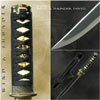 |
|
| Hanwei Wind & Thunder Tanto (SH5003) |
Points: 18
|
Each piece in the Wind & Thunder Set (SH5001 & SH5003) has a hand-forged 1065 high-carbon steel blade (nagasa) and is differentially tempered using a traditional claying method. The blades in the set feature a large o-kissaki. The Wind & Thunder Set is fitted with the black iron Raiden tsuba and Tomoe mon motif fuchi and kashira. The handle is wrapped in genuine ray skin (same) and the tsuka-ito and sageo are premium Japanese black cotton. The saya is done in a deep black lacquer and the sageo is black Japanese cotton. CAS/Hanwei have designed a cutting katana with thicker and heavier blades specifically for the martial artist that needs a sword for the demands of cutting the larger goza (tameshigiri). This set is ideal for those looking for a katana for the rigors of Battojutsu.
High-carbon steel blade
Deep black lacquer saya
Genuine ray skin
Sold Out
|
|
|
|
|
|
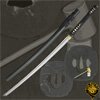 |
|
| Hanwei Tea Culture Katana (SH2331) |
Points: 30


|
In Japan the traditional method of serving tea is a celebrated art form in itself. This highly ritualized ceremony is an involved process, the most elaborate of which can last hours and is reserved for the most distinguished of guests. Our Tea Culture Daisho (SH2331, SH2332) captures the essence of this important tradition. The Katana and Wakizashi are built upon a traditional Shinogi Zukuri style blade with Bo-Hi. The high-carbon blade is hand forged and differentially hardened using the traditional clay method. The Koshirae (furniture) feature the typical elements present in a Japanese tea ceremony. The handle is wrapped with suede leather in a Katati Make (battle wrap) style.
Sold Out
|
|
|
|
|
|
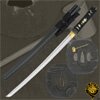 |
|
| Hanwei Tea Culture Wakizashi (SH2332) |
Points: 25


|
In Japan the traditional method of serving tea is a celebrated art form in itself. This highly ritualized ceremony is an involved process, the most elaborate of which can last hours and is reserved for the most distinguished of guests. Our Tea Culture Daisho (SH2331, SH2332) captures the essence of this important tradition. The Katana and Wakizashi are built upon a traditional Shinogi Zukuri style blade with Bo-Hi. The high-carbon blade is hand forged and differentially hardened using the traditional clay method. The Koshirae (furniture) feature the typical elements present in a Japanese tea ceremony. The handle is wrapped with suede leather in a Katati Make (battle wrap) style.
Sold Out
|
|
|
|
|
|
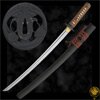 |
|
| Hanwei Three Monkey Wakizashi (SH2330) |
Points: 40

|
The "Three Wise Monkeys" is a popular symbol of the "See no evil, hear no evil, speak no evil" proverb popular in many cultures around the world. The proverb itself is thought to have originated in China and was brought to Japan by a Buddhist monk, while the association with three monkeys appears to be a Japanese play on words. Our Three Monkey Katana (SH2329) and Wakizashi (SH2330) are built on traditional Shinogi Zukuri style blades with Bo-Hi to reduce weight and improve balance. The high-carbon blade is hand forged and differentially hardened. The blackened iron Tsuba features the "Three Wise Monkeys" in relief.
Sold Out
|
|
|
|
|
|
 |
|
| Hanwei Bushido Wakizashi (SH1211) |
Points: 30

|
Each piece in the Bushido Series (SH1210, SH1211, & SH1212) has a hand-forged & folded K120C powder steel blade, differentially tempered using a traditional claying method to produce an HRC60 edge, HRC40 back. The temper line (hamon) is evident and prominent and the grain pattern (hada) shows distinct layers. The saya are deeply lacquered in gold with inlaid brass cherry blossom (sakura) flowers. High quality ray skin (same) is used on the tsuka of the katana and wakizashi, while the tsuka of the tanto is a gold-plated brass with a battle-scene decoration in relief. The tsuba of the katana and wakizashi is of blackened and bronzed iron, with detailing in gold and silver and a battle scene decoration. The tsuka-ito on the katana and wakizashi and the sageo on all three pieces are woven from premium Japanese cotton. The fuchi and kashira are of blackened bronze with brass detailing, and the kojiri, koiguchi and kurikata are of polished buffalo horn. The blade collar (habaki) is a one-piece brass construction. The katana and wakizashi blades are un-grooved, while the tanto blade is grooved (bo-hi) on both sides. The katana and wakizashi have medium-length (chu) kissaki. See Models SH1210 and SH1212 for the Katana and Tanto details.
Hand forged and folded steel blade
High quality
Traditional construction
Sold Out
|
|
|
|
|
|
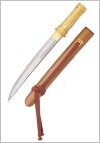 |
|
| Hanwei Bushido Tanto (SH1212) |
Points: 23

|
Each piece in the Bushido Series (SH1210, SH1211, & SH1212) has a hand-forged & folded K120C powder steel blade, differentially tempered using a traditional claying method to produce an HRC60 edge, HRC40 back. The temper line (hamon) is evident and prominent and the grain pattern (hada) shows distinct layers. The saya are deeply lacquered in gold with inlaid brass cherry blossom (sakura) flowers. High quality ray skin (same) is used on the tsuka of the katana and wakizashi, while the tsuka of the tanto is a gold-plated brass with a battle-scene decoration in relief. The tsuba of the katana and wakizashi is of blackened and bronzed iron, with detailing in gold and silver and a battle scene decoration. The tsuka-ito on the katana and wakizashi and the sageo on all three pieces are woven from premium Japanese cotton. The fuchi and kashira are of blackened bronze with brass detailing, and the kojiri, koiguchi and kurikata are of polished buffalo horn. The blade collar (habaki) is a one-piece brass construction. The katana and wakizashi blades are un-grooved, while the tanto blade is grooved (bo-hi) on both sides. The katana and wakizashi have medium-length (chu) kissaki. See Models SH1211 and SH1210 for the Wakizashi and Katana details.
Hand forged and folded steel blade
High quality
Traditional construction
Sold Out
|
|
|
|
|
|
 |
|
| Hanwei Ronin Katana (SH2360) |
Points: 50

|
The Story of the 47 Ronin is one of the most celebrated and influential tales of the Samurai from the Edo period. Lord Asano was a powerful Daimyo ordered by the Shogun to entertain guests of the Imperial Family. The highest ranking master of protocol, Kira, was given the task of teaching Asano, among others, proper matters of etiquette in this task. Lord Asano and Kira quickly grew to dislike each other and the teacher insulted his student at every opportunity. No longer able to contain himself, Asano drew his sword upon Kira, wounding him in the attack. This act led to Asano's ordered suicide (seppuku) and the confiscation of his property. On December 14, 1702, nearly one year after Asano's death, 47 of Asano's men (now Ronin), descended upon the mansion of Kira to exact their revenge.
Sold Out
|
|
|
|
|
|
 |
|
| Hanwei Tiger Katana (SH1204) |
Points: 51


|
Each piece in the Tiger group has a hand-forged and folded ASSAB-K120C powder steel blade, differentially tempered to produce an HRC60 edge, HRC40 back and a distinctive hamon. Saya are deeply lacquered in black, with inlaid brass bamboo leaves. The ray skin used on the tsuka is of the highest quality, and the tsuka-ito and sageo on all three pieces are woven from best quality Japanese cotton. The Fuchi, Kashira, Kojiri, Koiguchi and Kurigata are all made from blackened bronzed iron, selectively detailed in gold. The Tsuba of the Katana and Wakizashi are made from blackened iron, with a tiger inlaid in brass. The Habaki is of one-piece brass construction. The blades of all three pieces are grooved on both sides, with a short Kissaki on the Katana and Wakizashi. See Models SH1205 and SH1206 for the Wakizashi and Tanto details.
Hand forged and folded steel blades
Excellent quality
Traditional construction
Sold Out
|
|
|
|
|
|
|
|
Tags:
martial arts, katana, iaito, sword, fencing, tonfa, boken, bokken, kama, shinai, samuraj, judo, karate, kenjutsu, kenjitsu, ninja, kungfu,
|














